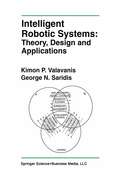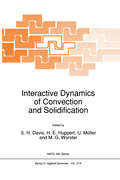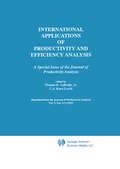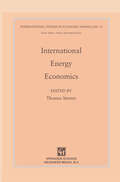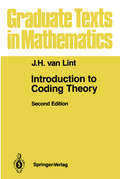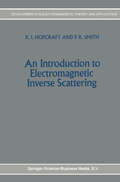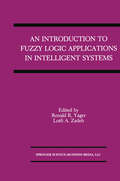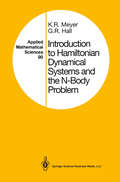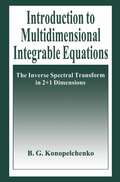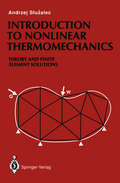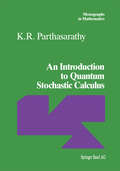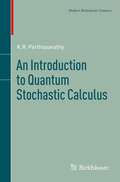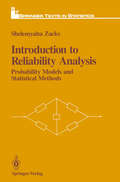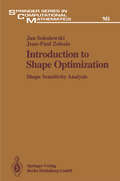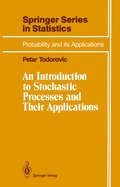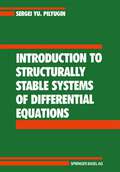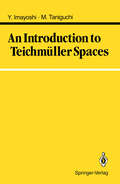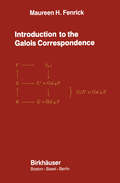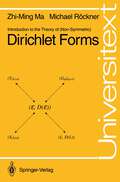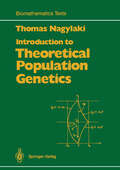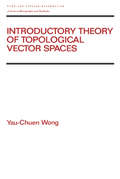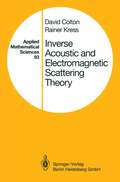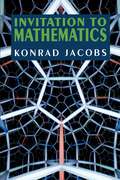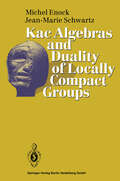- Table View
- List View
Intelligent Robotic Systems: Theory, Design and Applications (The Springer International Series in Engineering and Computer Science #182)
by Kimon P. Valavanis George N. SaridisSince the late 1960s, there has been a revolution in robots and industrial automation, from the design of robots with no computing or sensorycapabilities (first-generation), to the design of robots with limited computational power and feedback capabilities (second-generation), and the design of intelligent robots (third-generation), which possess diverse sensing and decision making capabilities. The development of the theory of intelligent machines has been developed in parallel to the advances in robot design. This theory is the natural outcome of research and development in classical control (1950s), adaptive and learning control (1960s), self-organizing control (1970s) and intelligent control systems (1980s). The theory of intelligent machines involves utilization and integration of concepts and ideas from the diverse disciplines of science, engineering and mathematics, and fields like artificial intelligence, system theory and operations research. The main focus and motivation is to bridge the gap between diverse disciplines involved and bring under a common cover several generic methodologies pertaining to what has been defined as machine intelligence. Intelligent robotic systems are a specific application of intelligent machines. They are complex computer controlled robotic systems equipped with a diverse set of visual and non visual sensors and possess decision making and problem solving capabilities within their domain of operation. Their modeling and control is accomplished via analytical and heuristic methodologies and techniques pertaining to generalized system theory and artificial intelligence. Intelligent Robotic Systems: Theory, Design and Applications, presents and justifies the fundamental concepts and ideas associated with the modeling and analysis of intelligent robotic systems. Appropriate for researchers and engineers in the general area of robotics and automation, Intelligent Robotic Systems is both a solid reference as well as a text for a graduate level course in intelligent robotics/machines.
Interactive Dynamics of Convection and Solidification (NATO Science Series E: #219)
by S. H. Davis H. E. Huppert U. Müller M. G. WorsterThe phase transformation from liquid to solid is a phenomenon central to a wide range of manufacturing and natural processes. The presence of phase transformation can drive convection in the melt through the liberation of latent heat, the rejection of solute, and the change of density upon freezing. The fluid mechanics itself can playa central role; the phase transformation can be strongly altered by convective transport in the liquid through the modification of the thermal and solutal environment of the solid-liquid interface; these local fields control the freezing characteristics at the interface. The convection can be generated naturally by buoyancy forces arising from gradients of temperature and concentration in the liquid, by density changes upon freezing, and by thermocapillary and solutocapillary forces on liquid-solid interfaces. The interactive coupling between solidification and convection forms the subject of this volume. Such coupled processes are significant on a large range of scales. Among the applications of interest are the manufacture of single crystals, the processing of surfaces using laser or molecular beams, and the processes of soldering and welding. One wants to understand and predict macrosegregation in castings, transport and fractionation in geological and geophysical systems, and heat accumulation in energy redistribution and storage systems. This volume contains papers presented at the NATO Advanced Research Workshop on "Interactive Dynamics of Convection and Solidification" held in Chamonix, France, March 8-13, 1992.
International Applications of Productivity and Efficiency Analysis: A Special Issue of the Journal of Productivity Analysis
by C. A. KnoxLovell Thomas R. GulledgeInternational Applications of Productivity and Efficiency Analysis features a complete range of techniques utilized in frontier analysis, including extensions of existing techniques and the development of new techniques. Another feature is that most of the contributions use panel data in a variety of approaches. Finally, the range of empirical applications is at least as great as the range of techniques, and many of the applications are of considerable policy relevance.
International Energy Economics (International Studies in Economic Modelling)
by T. SternerAn international collection of twenty papers with three themes: energy demand, modelling energy supply and models of specific markets.
Introduction to Coding Theory (Graduate Texts in Mathematics #86)
by J.H. van LintThe first edition of this book was conceived in 1981 as an alternative to outdated, oversized, or overly specialized textbooks in this area of discrete mathematics-a field that is still growing in importance as the need for mathematicians and computer scientists in industry continues to grow. The body of the book consists of two parts: a rigorous, mathematically oriented first course in coding theory followed by introductions to special topics. The second edition has been largely expanded and revised. The main editions in the second edition are: (1) a long section on the binary Golay code; (2) a section on Kerdock codes; (3) a treatment of the Van Lint-Wilson bound for the minimum distance of cyclic codes; (4) a section on binary cyclic codes of even length; (5) an introduction to algebraic geometry codes. Eindhoven J. H. VAN LINT November 1991 Preface to the First Edition Coding theory is still a young subject. One can safely say that it was born in 1948. It is not surprising that it has not yet become a fixed topic in the curriculum of most universities. On the other hand, it is obvious that discrete mathematics is rapidly growing in importance. The growing need for mathe maticians and computer scientists in industry will lead to an increase in courses offered in the area of discrete mathematics. One of the most suitable and fascinating is, indeed, coding theory.
An Introduction to Electromagnetic Inverse Scattering (Developments in Electromagnetic Theory and Applications #7)
by K.I. Hopcraft P.R. SmithAn Introduction to Fuzzy Logic Applications in Intelligent Systems (The Springer International Series in Engineering and Computer Science #165)
by Ronald R. Yager Lotfi A. ZadehAn Introduction to Fuzzy Logic Applications in Intelligent Systems consists of a collection of chapters written by leading experts in the field of fuzzy sets. Each chapter addresses an area where fuzzy sets have been applied to situations broadly related to intelligent systems. The volume provides an introduction to and an overview of recent applications of fuzzy sets to various areas of intelligent systems. Its purpose is to provide information and easy access for people new to the field. The book also serves as an excellent reference for researchers in the field and those working in the specifics of systems development. People in computer science, especially those in artificial intelligence, knowledge-based systems, and intelligent systems will find this to be a valuable sourcebook. Engineers, particularly control engineers, will also have a strong interest in this book. Finally, the book will be of interest to researchers working in decision support systems, operations research, decision theory, management science and applied mathematics. An Introduction to Fuzzy Logic Applications in Intelligent Systems may also be used as an introductory text and, as such, it is tutorial in nature.
Introduction to Hamiltonian Dynamical Systems and the N-Body Problem (Applied Mathematical Sciences #90)
by Kenneth Meyer Glen HallThe theory of Hamiltonian systems is a vast subject which can be studied from many different viewpoints. This book develops the basic theory of Hamiltonian differential equations from a dynamical systems point of view. That is, the solutions of the differential equations are thought of as curves in a phase space and it is the geometry of these curves that is the important object of study. The analytic underpinnings of the subject are developed in detail. The last chapter on twist maps has a more geometric flavor. It was written by Glen R. Hall. The main example developed in the text is the classical N-body problem, i.e., the Hamiltonian system of differential equations which describe the motion of N point masses moving under the influence of their mutual gravitational attraction. Many of the general concepts are applied to this example. But this is not a book about the N-body problem for its own sake. The N-body problem is a subject in its own right which would require a sizable volume of its own. Very few of the special results which only apply to the N-body problem are given.
Introduction to Multidimensional Integrable Equations: The Inverse Spectral Transform in 2+1 Dimensions (Plenum Monographs in Nonlinear Physics)
by B.G. KonopelchenkoThe soliton represents one ofthe most important ofnonlinear phenomena in modern physics. It constitutes an essentially localizedentity with a set ofremarkable properties. Solitons are found in various areas of physics from gravitation and field theory, plasma physics, and nonlinear optics to solid state physics and hydrodynamics. Nonlinear equations which describe soliton phenomena are ubiquitous. Solitons and the equations which commonly describe them are also of great mathematical interest. Thus, the dis covery in 1967and subsequent development ofthe inversescattering transform method that provides the mathematical structure underlying soliton theory constitutes one of the most important developments in modern theoretical physics. The inversescattering transform method is now established as a very powerful tool in the investigation of nonlinear partial differential equations. The inverse scattering transform method, since its discoverysome two decades ago, has been applied to a great variety of nonlinear equations which arise in diverse fields of physics. These include ordinary differential equations, partial differential equations, integrodifferential, and differential-difference equations. The inverse scattering trans form method has allowed the investigation of these equations in a manner comparable to that of the Fourier method for linear equations.
Introduction to Nonlinear Thermomechanics: Theory and Finite-Element Solutions
by Andrzej SluzalecProfessor Sluzalec is a well-known and respected authority in the field of Computational Mechanics, and his personal experience forms the basis of the book. Introduction to Nonlinear Thermomechanics provides both an elementary and advanced exposition of nonlinear thermomechanics. The scope includes theoretical aspects and their rational application in thermal problems, thermo-elastoplasticity, finite strain thermoplasticity and coupled thermoplasticity. The use of numerical techniques for the solution of problems and implementation of basic theory is included. Engineers, technicians, researchers, and advanced students will find the book an extremely useful compendium of solutions to problems. The scope is such that it would also be an effective teaching aid.
An Introduction to Quantum Stochastic Calculus (Monographs in Mathematics #85)
by K.R. Parthasarathy"Elegantly written, with obvious appreciation for fine points of higher mathematics...most notable is [the] author's effort to weave classical probability theory into [a] quantum framework." – The American Mathematical Monthly "This is an excellent volume which will be a valuable companion both for those who are already active in the field and those who are new to it. Furthermore there are a large number of stimulating exercises scattered through the text which will be invaluable to students." – Mathematical Reviews An Introduction to Quantum Stochastic Calculus aims to deepen our understanding of the dynamics of systems subject to the laws of chance both from the classical and the quantum points of view and stimulate further research in their unification. This is probably the first systematic attempt to weave classical probability theory into the quantum framework and provides a wealth of interesting features: The origin of Ito's correction formulae for Brownian motion and the Poisson process can be traced to communication relations or, equivalently, the uncertainty principle.Quantum stochastic interpretation enables the possibility of seeing new relationships between fermion and boson fields.Quantum dynamical semigroups as well as classical Markov semigroups are realized through unitary operator evolutions. The text is almost self-contained and requires only an elementary knowledge of operator theory and probability theory at the graduate level.
An Introduction to Quantum Stochastic Calculus (Modern Birkhäuser Classics)
by K.R. ParthasarathyAn Introduction to Quantum Stochastic Calculus aims to deepen our understanding of the dynamics of systems subject to the laws of chance both from the classical and the quantum points of view and stimulate further research in their unification. This is probably the first systematic attempt to weave classical probability theory into the quantum framework and provides a wealth of interesting features: The origin of Ito’s correction formulae for Brownian motion and the Poisson process can be traced to commutation relations or, equivalently, the uncertainty principle.Quantum stochastic integration enables the possibility of seeing new relationships between fermion and boson fields.Many quantum dynamical semigroups as well as classical Markov semigroups are realised through unitary operator evolutions. The text is almost self-contained and requires only an elementary knowledge of operator theory and probability theory at the graduate level. - - - This is an excellent volume which will be a valuable companion both to those who are already active in the field and those who are new to it. Furthermore there are a large number of stimulating exercises scattered through the text which will be invaluable to students. (Mathematical Reviews) This monograph gives a systematic and self-contained introduction to the Fock space quantum stochastic calculus in its basic form (...) by making emphasis on the mathematical aspects of quantum formalism and its connections with classical probability and by extensive presentation of carefully selected functional analytic material. This makes the book very convenient for a reader with the probability-theoretic orientation, wishing to make acquaintance with wonders of the noncommutative probability, and, more specifcally, for a mathematics student studying this field. (Zentralblatt MATH)Elegantly written, with obvious appreciation for fine points of higher mathematics (...) most notable is [the] author's effort to weave classical probability theory into [a] quantum framework.(The American Mathematical Monthly)
Introduction to Reliability Analysis: Probability Models and Statistical Methods (Springer Texts in Statistics)
by Shelemyahu ZacksReliability analysis is concerned with the analysis of devices and systems whose individual components are prone to failure. This textbook presents an introduction to reliability analysis of repairable and non-repairable systems. It is based on courses given to both undergraduate and graduate students of engineering and statistics as well as in workshops for professional engineers and scientists. As aresult, the book concentrates on the methodology of the subject and on understanding theoretical results rather than on its theoretical development. An intrinsic aspect of reliability analysis is that the failure of components is best modelled using techniques drawn from probability and statistics. Professor Zacks covers all the basic concepts required from these subjects and covers the main modern reliability analysis techniques thoroughly. These include: the graphical analysis of life data, maximum likelihood estimation and bayesian likelihood estimation. Throughout the emphasis is on the practicalities of the subject with numerous examples drawn from industrial and engineering settings.
Introduction to Shape Optimization: Shape Sensitivity Analysis (Springer Series in Computational Mathematics #16)
by Jan Sokolowski Jean-Paul ZolesioThis book is motivated largely by a desire to solve shape optimization prob lems that arise in applications, particularly in structural mechanics and in the optimal control of distributed parameter systems. Many such problems can be formulated as the minimization of functionals defined over a class of admissible domains. Shape optimization is quite indispensable in the design and construction of industrial structures. For example, aircraft and spacecraft have to satisfy, at the same time, very strict criteria on mechanical performance while weighing as little as possible. The shape optimization problem for such a structure consists in finding a geometry of the structure which minimizes a given functional (e. g. such as the weight of the structure) and yet simultaneously satisfies specific constraints (like thickness, strain energy, or displacement bounds). The geometry of the structure can be considered as a given domain in the three-dimensional Euclidean space. The domain is an open, bounded set whose topology is given, e. g. it may be simply or doubly connected. The boundary is smooth or piecewise smooth, so boundary value problems that are defined in the domain and associated with the classical partial differential equations of mathematical physics are well posed. In general the cost functional takes the form of an integral over the domain or its boundary where the integrand depends smoothly on the solution of a boundary value problem.
An Introduction to Stochastic Processes and Their Applications (Springer Series in Statistics)
by Petar TodorovicThis text on stochastic processes and their applications is based on a set of lectures given during the past several years at the University of California, Santa Barbara (UCSB). It is an introductory graduate course designed for classroom purposes. Its objective is to provide graduate students of statistics with an overview of some basic methods and techniques in the theory of stochastic processes. The only prerequisites are some rudiments of measure and integration theory and an intermediate course in probability theory. There are more than 50 examples and applications and 243 problems and complements which appear at the end of each chapter. The book consists of 10 chapters. Basic concepts and definitions are pro vided in Chapter 1. This chapter also contains a number of motivating ex amples and applications illustrating the practical use of the concepts. The last five sections are devoted to topics such as separability, continuity, and measurability of random processes, which are discussed in some detail. The concept of a simple point process on R+ is introduced in Chapter 2. Using the coupling inequality and Le Cam's lemma, it is shown that if its counting function is stochastically continuous and has independent increments, the point process is Poisson. When the counting function is Markovian, the sequence of arrival times is also a Markov process. Some related topics such as independent thinning and marked point processes are also discussed. In the final section, an application of these results to flood modeling is presented.
Introduction to Structurally Stable Systems of Differential Equations
by S.Y. PilyuginThis book is based on a one year course of lectures on structural sta bility of differential equations which the author has given for the past several years at the Department of Mathematics and Mechanics at the University of Leningrad. The theory of structural stability has been developed intensively over the last 25 years. This theory is now a vast domain of mathematics, having close relations to the classical qualitative theory of differential equations, to differential topology, and to the analysis on manifolds. Evidently it is impossible to present a complete and detailed account of all fundamental results of the theory during a one year course. So the purpose of the course of lectures (and also the purpose of this book) was more modest. The author was going to give an introduction to the language of the theory of structural stability, to formulate its principal results, and to introduce the students (and also the readers of the book) to some of the main methods of this theory. One can select two principal aspects of modern theory of structural stability (of course there are some conventions attached to this state ment). The first one, let us call it the "geometric" aspect, deals mainly with the description of the picture of trajectories of a system; and the second, let us say the "analytic" one, has in its centre the method for solving functional equations to find invariant manifolds, conjugating homeomorphisms, and so forth.
Introduction to the Galois Correspondence
by Maureen H. FenrickIn this presentation of the Galois correspondence, modem theories of groups and fields are used to study problems, some of which date back to the ancient Greeks. The techniques used to solve these problems, rather than the solutions themselves, are of primary importance. The ancient Greeks were concerned with constructibility problems. For example, they tried to determine if it was possible, using straightedge and compass alone, to perform any of the following tasks? (1) Double an arbitrary cube; in particular, construct a cube with volume twice that of the unit cube. (2) Trisect an arbitrary angle. (3) Square an arbitrary circle; in particular, construct a square with area 7r. (4) Construct a regular polygon with n sides for n > 2. If we define a real number c to be constructible if, and only if, the point (c,O) can be constructed starting with the points (0,0) and (1,0), then we may show that the set of constructible numbers is a subfield of the field R of real numbers containing the field Q of rational numbers. Such a subfield is called an intermediate field of Rover Q. We may thus gain insight into the constructibility problems by studying intermediate fields of Rover Q. In chapter 4 we will show that (1) through (3) are not possible and we will determine necessary and sufficient conditions that the integer n must satisfy in order that a regular polygon with n sides be constructible.
Introduction to the Theory of (Universitext)
by Zhi-Ming Ma Michael RöcknerThe purpose of this book is to give a streamlined introduction to the theory of (not necessarily symmetric) Dirichlet forms on general state spaces. It includes both the analytic and the probabilistic part of the theory up to and including the construction of an associated Markov process. It is based on recent joint work of S. Albeverio and the two authors and on a one-year-course on Dirichlet forms taught by the second named author at the University of Bonn in 1990/9l. It addresses both researchers and graduate students who require a quick but complete introduction to the theory. Prerequisites are a basic course in probabil ity theory (including elementary martingale theory up to the optional sampling theorem) and a sound knowledge of measure theory (as, for example, to be found in Part I of H. Bauer [B 78]). Furthermore, an elementary course on lin ear operators on Banach and Hilbert spaces (but without spectral theory) and a course on Markov processes would be helpful though most of the material needed is included here.
Introduction to Theoretical Population Genetics (Biomathematics #21)
by Thomas NagylakiThis book covers those areas of theoretical population genetics that can be investigated rigorously by elementary mathematical methods. I have tried to formulate the various models fairly generally and to state the biological as sumptions quite explicitly. I hope the choice and treatment of topics will en able the reader to understand and evaluate detailed analyses of many specific models and applications in the literature. Models in population genetics are highly idealized, often even over idealized, and their connection with observation is frequently remote. Further more, it is not practicable to measure the parameters and variables in these models with high accuracy. These regrettable circumstances amply justify the use of appropriate, lucid, and rigorous approximations in the analysis of our models, and such approximations are often illuminating even when exact solu tions are available. However, our empirical and theoretical limitations justify neither opaque, incomplete formulations nor unconvincing, inadequate analy ses, for these may produce uninterpretable, misleading, or erroneous results. Intuition is a principal source of ideas for the construction and investigation of models, but it can replace neither clear formulation nor careful analysis. Fisher (1930; 1958, pp. x, 23-24, 38) not only espoused similar ideas, but he recognized also that our concepts of intuition and rigor must evolve in time. The book is neither a review of the literature nor a compendium of results. The material is almost entirely self-contained. The first eight chapters are a thoroughly revised and greatly extended version of my published lecture notes (Nagylaki, 1977a).
Introductory Theory of Topological Vector SPates (Chapman And Hall/crc Pure And Applied Mathematics Ser.)
by Yau-Chuen WongThis text offers an overview of the basic theories and techniques of functional analysis and its applications. It contains topics such as the fixed point theory starting from Ky Fan's KKM covering and quasi-Schwartz operators. It also includes over 200 exercises to reinforce important concepts.;The author explores three fundamental results on Banac
Introductory Theory of Topological Vector SPates (Chapman And Hall/crc Pure And Applied Mathematics Ser.)
by Yau-Chuen WongThis text offers an overview of the basic theories and techniques of functional analysis and its applications. It contains topics such as the fixed point theory starting from Ky Fan's KKM covering and quasi-Schwartz operators. It also includes over 200 exercises to reinforce important concepts.;The author explores three fundamental results on Banach spaces, together with Grothendieck's structure theorem for compact sets in Banach spaces (including new proofs for some standard theorems) and Helley's selection theorem. Vector topologies and vector bornologies are examined in parallel, and their internal and external relationships are studied. This volume also presents recent developments on compact and weakly compact operators and operator ideals; and discusses some applications to the important class of Schwartz spaces.;This text is designed for a two-term course on functional analysis for upper-level undergraduate and graduate students in mathematics, mathematical physics, economics and engineering. It may also be used as a self-study guide by researchers in these disciplines.
Inverse Acoustic and Electromagnetic Scattering Theory (Applied Mathematical Sciences #93)
by David Colton Rainer KressIt has now been almost ten years since our first book on scattering theory ap peared [32]. At that time we claimed that "in recent years the development of integral equation methods for the direct scattering problem seems to be nearing completion, whereas the use of such an approach to study the inverse scattering problem has progressed to an extent that a 'state of the art' survey appears highly desirable". Since we wrote these words, the inverse scattering problem for acoustic and electromagnetic waves has grown from being a few theoreti cal considerations with limited numerical implementations to a weH developed mathematical theory with tested numerical algorithms. This maturing of the field of inverse scattering theory has been based on the realization that such problems are in general not only nonlinear but also improperly posed in the sense that the solution does not depend continuously on the measured data. This was emphasized in [32] and treated with the ideas and tools available at that time. Now, almost ten years later, these initial ideas have developed to the extent that a monograph summarizing the mathematical basis of the field seems appropriate. This book is oUf attempt to write such a monograph. The inverse scattering problem for acoustic and electromagnetic waves can broadly be divided into two classes, the inverse obstacle problem and the inverse medium problem.
Invitation to Mathematics
by Konrad JacobsBased on a well-received course designed for philosophy students, this book is an informal introduction to mathematical thinking. The work will be rewarding not only for philosophers concerned with mathematical questions but also for serious amateur mathematicians with an interest in the "frontiers" as well as the foundations of mathematics. In what might be termed a sampler of the discipline, Konrad Jacobs discusses an unusually wide range of topics, including such items of contemporary interest as knot theory, optimization theory, and dynamical systems. Using Euclidean geometry and algebra to introduce the mathematical mode of thought, the author then turns to recent developments. In the process he offers what he calls a "Smithsonian of mathematical showpieces": the five Platonic Solids, the Mbius Strip, the Cantor Discontinuum, the Peano Curve, Reidemeister's Knot Table, the plane ornaments, Alexander's Horned Sphere, and Antoine's Necklace. The treatments of geometry and algebra are followed by a chapter on induction and one on optimization, game theory, and mathematical economics. The chapter on topology includes a discussion of topological spaces and continuous mappings, curves and knots, Euler's polyhedral formula for surfaces, and the fundamental group. The last chapter deals with dynamics and contains material on the Game of Life, circle rotation, Smale's "horseshoe," and stability and instability, among other topics.
Kac Algebras and Duality of Locally Compact Groups
by Michel Enock Jean-Marie SchwartzThis book deals with the theory of Kac algebras and their dual ity, elaborated independently by M. Enock and J . -M. Schwartz, and by G. !. Kac and L. !. Vajnermann in the seventies. The sub ject has now reached a state of maturity which fully justifies the publication of this book. Also, in recent times, the topic of "quantum groups" has become very fashionable and attracted the attention of more and more mathematicians and theoret ical physicists. One is still missing a good characterization of quantum groups among Hopf algebras, similar to the character ization of Lie groups among locally compact groups. It is thus extremely valuable to develop the general theory, as this book does, with emphasis on the analytical aspects of the subject instead of the purely algebraic ones. The original motivation of M. Enock and J. -M. Schwartz can be formulated as follows: while in the Pontrjagin duality theory of locally compact abelian groups a perfect symmetry exists between a group and its dual, this is no longer true in the various duality theorems of T. Tannaka, M. G. Krein, W. F. Stinespring . . . dealing with non abelian locally compact groups. The aim is then, in the line proposed by G. !. Kac in 1961 and M. Takesaki in 1972, to find a good category of Hopf algebras, containing the category of locally compact groups and fulfilling a perfect duality.
